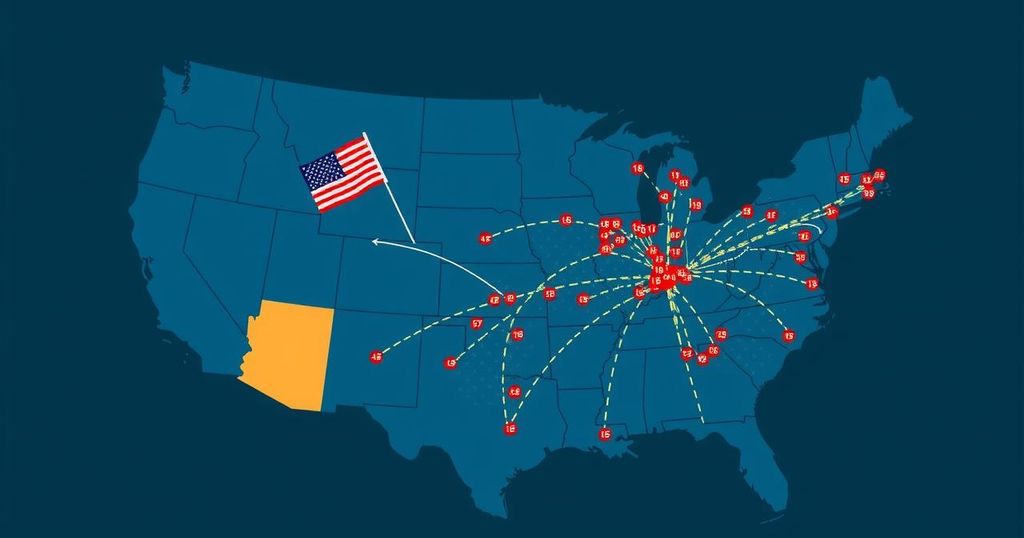The Uncertain Path to the 2024 Presidential Election: Harris vs. Trump
With the presidential election looming on November 5th, current polling indicates a tight race between Kamala Harris and Donald Trump, with little change despite numerous impactful events. Voter turnout is identified as the crucial factor, given the absence of unpredictable shifts in public opinion. Both campaigns are actively engaged in strategies aimed at mobilizing voters and preparing for potential legal disputes following the election outcomes, underscoring the importance of participation in shaping the results.
As the countdown to the American presidential election on November 5th continues, political observers in Washington find themselves in a state of anxious calm, devoid of any clear indicators on which way the race between Vice President Kamala Harris and former President Donald Trump will swing. Instead of a predictable trajectory influenced by significant events, the election signifies an unprecedented stability in polling data that raises questions about voter behavior and turnout dynamics. Over recent months, despite numerous incidents—ranging from international conflicts to assassination attempts against Donald Trump—the race remains surprisingly static. Detailed analysis shows polling averages fluctuating marginally; for instance, Harris led Trump by a mere 1.2 points in August, climbing to 2.1 points by mid-October. Such minor shifts occur within a broader context of poll stability unseen in previous elections. The historical precedent indicates that American voters have been susceptible to changes in opinion during critical times, yet contemporary polarization suggests that most voters have made their decisions well in advance, with actual turnout becoming the paramount factor rather than persuasion. The polls depict an exceptionally tight contest, with many averages reflecting that the candidates exist in a statistical tie, often falling within the margin of error. This scenario is atypical since, in most modern elections, a clearer front-runner typically emerges by this stage. Consequently, the lack of predictive clarity in this election has shifted the strategic focus to two main avenues: mobilizing voter turnout and managing the integrity of the voting process. Efforts to bolster voter turnout have taken center stage, as both the Harris and Trump campaigns initiate aggressive outreach initiatives aimed at engaging apathetic voters. Particularly notable is Harris’s campaign, with 2,500 staff assisting on the ground in swing states to encourage electoral participation through door-to-door canvassing efforts. Simultaneously, the Republican Party is preparing for potential disputes regarding the election results, with Trump likely to challenge outcomes should he lose. Unlike previous efforts, which were deemed haphazard and ineffective, the GOP has crafted a more thorough legal strategy to contest voting regulations, laying the groundwork for potential litigation that could impact the election outcome. In summary, as voting day approaches, neither candidate has an assured path to victory, creating an unpredictable atmosphere in Washington. Although ample discussion surrounds the probabilities of each candidate winning, the reality remains that significant changes in opinion are unlikely at this stage. The final outcome on November 5th is ultimately uncertain, contributing to the ongoing intrigue and analysis surrounding this monumental electoral event.
The article discusses the current state of the upcoming American presidential election, highlighting the unusual stability in polling data and the lack of significant shifts in public opinion as Election Day approaches. It elucidates how the dynamics of the race are being shaped more by turnout operations rather than shifts in voter sentiment or last-minute surprises. The roles of the two candidates, Kamala Harris and Donald Trump, are central to the analysis, as well as the strategies being employed by each campaign to influence voter behavior and counter potential legal challenges post-election.
In conclusion, the current political landscape leading up to the November 5th presidential election reveals a unique scenario where both candidates are statistically tied, and traditional indicators of electoral success are absent. Efforts concentrated on maximizing voter turnout and preparing for electoral disputes signify the evolving nature of American elections. The unprecedented stability of polling and the fierce focus on turnout rather than persuasion underscore the anticipation of a highly competitive electoral battle, the outcome of which remains uncertain until all ballots are cast and counted.
Original Source: ecfr.eu




Post Comment